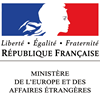Welcome to France at the Cité internationale de la francophonie in Villers-Cotterêt

50 of us, French and foreign friends, set off on a journey of learning and fun to discover the Cité
internationale de la langue française at the Château royal de Villers-Cotterêt.
Xavier Bailly, the Château’s administrator, is all smiles as he stands in front of the entrance door,
which still bears the inscription ‘Maison de retraite du département de la Seine’ (‘Retirement home
of the Seine region’). This Renaissance château has become grandiose once again. It was built for
François 1er, where the king signed the famous decree of 1539 making French the official language
of the administration.
A brief history takes us from the King’s castle to that of Philippe d’Orléans, brother of Louis XIV.
Seized as national property during the French Revolution, it was transformed in 1804 into a
beggar’s warehouse ‘to be used for the confinement of the beggars and vagrants of Paris’, then it
became a retirement home from 1889 to 2014 before being abandoned. Ten years later, it has been
resurrected. The salamanders, the royal cypher and the fleur-de-lys of François 1st have been
returned to their rightful place on the grand staircase and in the chapel. These ornamental treasures
coexist with the glass roof of the former jeu de paume, decorated with a lexical sky covered with a
variety of words such as ‘saperlipopette’, ‘égalité’ and ‘faire palabre’. On the subject of jeu de
paume, Mr Bailly tells us how this sport, which has been very popular in France since the 13th
century, is the origin of the word ‘tennis’:
"The waiter would announce “tenez”, which means “take”, before throwing the ball to his
opponent; English speakers have transformed this into “tennis”.
And now we come to the heart of the matter. Some sixty audiovisual and digital devices are
deployed in fifteen rooms. Let’s take a few examples: the language comparator greatly amused our
foreign friends. We discover that the expression ‘Avoir le cafard’ (‘feeling blue’) is in English,
‘Tenir el bajon’ (‘getting depressed’) in Spanish, ‘Trübsal blasen’ (‘melancholy’) in German and ‘In
de put sitzen’ (‘in the well’) in Dutch. A little further on, you’re supposed to rearrange the letters of
a word to create a new word. Dog can become doghouse. You learn something new every day. As
for ‘couvent’, French ingenuity knows no bounds: Les poules du couvent couvent". Poor foreigners!
Some were able to raise their heads when they saw the display devoted to the wealth of French
expressions: ‘Larg pas la patate’, ‘Tenir bon à la Réunion’. ‘Avoir le dos’ means having influential
connections in West Africa. ‘Avoir la jasette’, to talk a lot in Canada.
We also move on from the widely celebrated Molière, who invented the expression ‘getting ideas’,
to the library of François 1er, which contains incunabula (printed before 1501) and rare works by
Rabelais and Pierre Ronsard. Other masterpieces accompany us, including paintings and tapestries.
As we headed back to our coach, we didn’t have to endure the ‘national downpour’ (a heavy
downpour in Belgium), but enjoyed a good lunch. The silence was not deafening, another
expression to remember. And we were far from feeling blue in any language.
Francine Boidevaix


